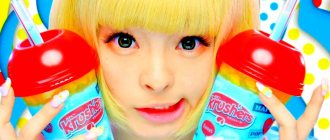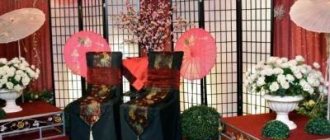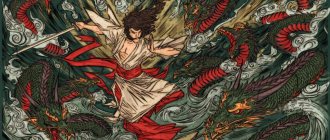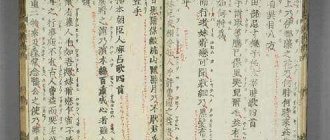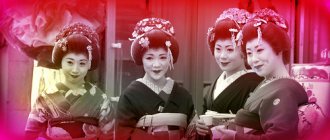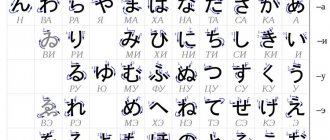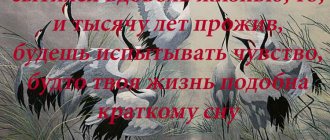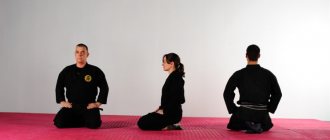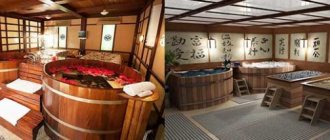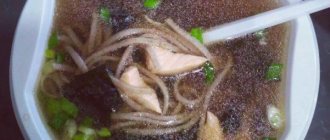Description
Japanese folklore states that any cat can turn into a magical creature if it lives more than 13 years, weighs 3.75 kg or more, and has a long tail. To turn into a mystical creature, it is enough to fulfill one condition. If a long-tailed beast becomes a demon, the tail will fork. Such a creature has its own name - nekomata. The werewolf's powers are great: bakeneko creates balls of fire, walks on two legs, and revives the dead by jumping over a corpse. If the owner angers the animal, the bakeneko will eat it and take on its appearance.
Mysterious werewolves
A separate interesting part of mythology is the story about the nekomata. This demon with a forked tail came from China and spread myths throughout the Japanese islands. It is believed that youkai live not only in human houses, but also in the mountains. These nekomata are wild and especially strong. Presumably the story takes its roots from veterinary medicine: it has long been known that animals can contract rabies. In Japan, painful diseases are called “nekomata diseases.” It is assumed that the legend about youkai comes from the impressions that ancient people formed when observing cats with rabies.
More often bakeneko become tricolor cats. Being werewolves, they often transform into women rather than men. Sometimes bakeneko is the spirit of a dead woman who wants revenge. Often, youkai gather in a flock to provide the leader with all the opportunities for revenge.
Yokai
Occasionally bakeneko help people, but they are cunning and insidious, they only do what is beneficial to themselves. Sometimes they take the form of incredible beauties and invite travelers to mountain springs. Those who agree become cats and cannot return to the human world.
Nekomata is a type of bakeneko.
Nekomata is a creature whose name has three decodings: “cat again”, “cat with a double tail”, or the random use of the final hieroglyph, consonant with the established word. Japanese culture is closely related to geographical features, so the term may be due to the widespread distribution of monkeys in mountainous areas.
The mountain magic cat originated in China. In Japan, it is found in the “Notes of a Clear Moon”: supposedly in 1233 in Nanto, a demon swallowed several residents. Mountain nekomata have cat-like eyes and an elongated body, like a dog's. “Notes from Boredom” tells that creatures live deep in the mountains. Tales of the Night Watch describes the ability of demons to turn into humans. Over the centuries, people have imagined nekomata to be larger: in 1749, a story was recorded about the capture of a youkai similar in size to a wild boar. In 1775, in Wakun no Shiori, youkai were described as being comparable in size to leopards, and in 1809, in Guiso, the body length was designated as 2.8 meters. Presumably, the legends are associated with attacks on people by large wild cats in the Fukushima region.
Demon cat
The collection “Cocoon Temonshu” first mentions domestic werecats. He tells how one animal, who lived in the mountains in a house on the edge of a cliff, grabbed a sword-amulet and ran away with it. Although the owners chased the animal, the cat successfully escaped. In the Edo era, they believed that old domestic cats turned into youkai, so they did not keep the animals for long. Modern researchers have established that the legend stems from the fact that in aging cats, the skin hanging from the back creates the illusion of a second tail.
Nekomata
For the Japanese, cats are associated with death, so in the past they were treated cruelly. There was a belief that the clan of a cat killer receives a curse for 7 generations. It was believed that youkai cats were more evil and more dangerous than other werewolves. They are carnivorous, smell rot from afar, and are not afraid of the dead. They believed that the powers of a youkai depended on how cruelly the living beast was treated. To prevent turning into a demon, cats had their tails cut off.
Skills, powers and abilities
Bakeneko have magical powers and necromancy abilities. They raise the dead with dances and gestures, jumping over the corpse.
Creatures can:
- summon ghostly balls of fire;
- take the form of an absorbed person;
- speak humanly;
- curse.
Mystical cats
Diet of Japanese Bobtails
Energetic Japanese Bobtails require a balanced diet. It is better to purchase special food for the breed, although it is sold in rare stores. You can order specialized food for bobtails directly on Asian websites.
At least sixty percent of the diet of Japanese bobtails should consist of meat - these animals are exclusively predators, moreover, they have hunting instincts. In the summer, when walking, Japanese bobtails readily eat grass, but for the winter it should be grown in special pots. This will establish the vitamin balance in the cat’s body.
Eighty kilocalories of feed should be per kilogram of weight of an adult animal. Natural food – 30 grams per kilogram of cat’s weight.
Important foods to include in your Japanese Bobtail diet:
- Horse meat, veal, beef - the meat should not be fatty and tough;
- Chicken and turkey;
- Buckwheat, rice, millet, oatmeal - other cereals are not welcome in a cat’s diet;
- Sea fish;
- Low-fat dairy products such as cottage cheese, kefir, sour cream;
- Boiled lungs, liver, kidneys, heart;
- Crushed boiled eggs.
Raw meat must be treated for parasites. To do this, you need to either boil it a little or freeze it for at least 12 hours. After frost, it is poured with boiling water and thawed. The meat should not be warm or cold: it must be at room temperature. Japanese Bobtails will not eat leftover food, so they must be removed immediately. These cats also do not drink dirty water.
At an early age, kittens receive nutrition from their mother. A little later, they should be fed at least six times a day on demand - a growing organism requires a lot of calories. Gradually, meals should be reduced to twice a day.
Myths and legends about Bakeneko
A long time ago, a cat settled in an abandoned temple. When a traveler approached, she went out to the threshold, sat down and raised her paw, inviting him inside. The person received shelter, rested his soul and body. This legend is the brightest of those telling about bakeneko.
Bakeneko appears in popular belief
Another story is about the murder of a Go opponent, Ryuzoji Mataichiro, by Prince Nabeshima Mitsushige. The mother of the murdered man, consumed by the pain of loss, told about this to the domestic cat, who invited the woman to sacrifice herself. After drinking her blood, the cat became a werewolf. She visited Nabeshima every night, torturing him. The prince fell ill, lost his child, and then lost all his servants - they were killed by a huge cat. The monster was defeated by Nabeshima's loyal servant Chibu Motoemon. The tomb of the terrible cat is located near Shiroishi in Saga at Shurin-ji Temple.
Yamato Kaiiki is about a haunted house owned by a wealthy samurai. He tried to cleanse his home of otherworldly forces, called priests and shamans, but no one could help. One day a servant noticed a suspicious cat and killed it with an arrow to the head. It turned out that the animal had two tails; he has already converted to bakeneko. After defeating the beast, the subnormal phenomena disappeared.
Breeding Japanese Bobtails
Japanese bobtails are difficult to breed, since their numbers in the CIS countries are not large, so it is difficult to find a good mate for a pet. Some breeders turn to European catteries to provide them with a female cat for mating. The partner is selected, first of all, by the length of the tail.
Only cats that meet absolutely all breed standards without exception are allowed to breed. Others are not allowed for breeding, since such crossing can cause pathologies. Likewise, Japanese Bobtails are not allowed to be crossed with cats of other breeds: this can lead to curvature of the spine or tail.
Interesting fact: When choosing a partner for your pet, pay attention to the pedigree - there should be no admixtures of other breeds there. The cat's tail must have a length of eight to twelve cm. The cat must be healthy and active, and the color must meet the standards.
Cats are allowed to breed at the age of two years, when she has gone through at least three heats. Early pregnancy is fraught with the death of the cat or miscarriages, and the cat can also acquire chronic diseases, and the kittens can be born weak. Cats are allowed to breed at one and a half years old, but the first cat must be experienced.
Without harm to health, cats can give birth no more than twice a year, but it is better to minimize the number of births - they greatly wear out the body. A bobtail cat does not have more than four kittens in a litter, but they are extremely tenacious and strong.
Bakeneko in modern culture
Images of magical cats appear in popular works:
- Nurarihyon no Mago - a clan of mystical cats;
- Soul Eater - Blair the cat, who turns into a beautiful girl;
- Ayakashi: Japanese Classic Horror is a classic bakeneko.
The most popular image is nekomusume, a catwoman. Nekomimi (cat ears) and other animal attributes are often used in modern culture. This is especially noticeable in cosplay.
Neko cosplay
Where are masks useful?
The product has a wide range of applications. If you make a cat mask, it can be used for the following purposes:
- The product is perfect for a masquerade, theme party (Halloween).
- The mask can be an addition to a child’s carnival costume for a party in kindergarten or school.
- A toy for children that can be used to play home theater or other role-playing games.
- Can be used as theatrical props in productions and performances.
- Especially beautifully decorated products can be an excellent decoration for the interior of a children's room.
The principle of use largely depends on the model and method of making the mask. For example, a mask for themed parties should not be made from colored paper. What is needed here is a more durable and beautifully finished structure.
Printable carnival mask templates
A cat mask can be made in different ways and represent correspondingly diverse designs. In this case, the simplest manufacturing method is to cut out a finished template, which can be printed on a color printer. Several options for ready-made templates:
- A template, which is a figured basis for an individual type of finishing.
- Template for making a domestic cat mask.
- Realistic template with the smallest details of a ginger cat.
- Template for making a mask of a black bully cat.
There are a huge variety of ready-made templates for printing and cutting. The muzzles have different colors, shapes, themes, and designs. The only drawback of such products is that they are quite fragile and will definitely not harmonize with a beautiful carnival costume.
Venetian cat mask
What is the difference between a Venetian mask and a regular cat mask? How to make a cat mask according to Venetian standards? It turns out to be very simple. It is enough to apply a characteristic coloring to a papier-mâché blank you have already made with your own hands and glue a stick to it. The Venetian mask of a woman is usually decorated with gold patterns, lace, ornaments and is supported with a stick.
Ready-made mask templates
The easiest option is to find a mask template with an interesting theme. If you don’t have a color printer, you can print a black and white image and color it with paints and pencils. In the graphic editor, you can select the size of the cat woman mask with your own hands to match the parameters of your face.
There are two ways to create a product using a template. In the first case, you can print the simplest version on paper and color the base with paint or ink. Try on the design and make fastenings.
A DIY cat mask made from a simple template can become a real work of art. Even the most ordinary preparation can look simply super.
Felt can be used as a base; the material is sufficiently dense and holds its shape. You can easily sew decor onto it using a needle and thread.
For reference! It is worth adding original beads, feathers and rhinestones to create a sophisticated accessory.
- Cat mask for kids
For cultural events in a kindergarten or school, you will need a cat mask for children. Parents can make such an accessory after studying the master class; it is important to know the theme of the holiday, the child’s preferences, whether a girl or boy needs an attribute.
Instructions on the Internet will tell parents how to make a cat mask for a children's party. The appearance of the product can be like in a cartoon with your favorite character. If the scene involves a certain character, then you should carefully read the script and reflect the image of the hero when creating the mask.
How to make a cat mask
The children's version will be different from the adult version. This attribute is suitable for a children's matinee and costume party. There is an interesting trick to make an accessory on a holder. This design will allow the attribute to be used in skits and performances.
A sheet of paper or cardboard should be folded in half and then crosswise. From the line where the folds intersect on the workpiece, mark 1.5-2 cm to the left and right. In this place you need to cut out eyes with a diameter of 4-5 cm.
- To create a voluminous model along the contours of the head, darts should be made along the temples, on the forehead in the middle of the eyebrow and from below to the tip of the nose on both sides.
- Along the long side, bend the base in half and make a pinch using a stapler on the reverse side measuring 2-3 mm between the eyes. Bring the frontal darts together by 0.5 cm and secure with quick-drying glue.
- On the contrary, the temple areas should be stretched and pieces of cardboard or paper glued on the back side. In these places you can immediately glue an elastic band for fixation.
- The free edges of the cuts in the lower part should be brought together and glued to form the muzzle and nose.
- Make ears from the base material and glue them to the mask. If desired, the base can be painted or decorative elements can be added.
Paper cat mask
The product of cellulose processing is the lightest, most accessible material in our homes for making various crafts. The easiest way is to make your own cat mask out of paper. To do this you only need:
Work order
Bend it again along the long side and make a small pinch (2-3 mm) with your own hands from the inside with a stapler between the eye holes. Bring the frontal grooves together by 0.5 cm and glue the edges of the paper.
Separate the temporal slits by 0.5 cm and glue in triangular pieces of thick paper or cardboard. In these places you will attach elastic bands or braid.
Bring the edges of the cuts in the lower part of the nose to the center, as shown in the photo, and glue them together. Cut out and attach the ears.
Apply war paint to your mask yourself. Pierce the cheeks with an awl and thread pieces of fishing line-tendrils through the holes. Secure their ends on the wrong side with pieces of tape. Sew a braid or elastic band to secure the paper cat mask to the head.
How to make a cat mask from paper and cardboard
A DIY cat mask can be made quickly and without any problems, if the designs are not too complex. Most often, paper or cardboard is used as a base. Using such raw materials, it is worth deciding on the type of construction. There are several options regarding how to make a cat mask. Here are the 2 simplest ones.
Step-by-step assembly of a cat mask
You can make crafts from regular colored paper. In this case, you additionally need to take scissors and glue.
A cat head mask made of paper is made in accordance with the following algorithm:
1. Fold a sheet of paper in half. There is no need to form a deep crease line. This technique is used to ensure that both sides of the mask are symmetrical in the future. Draw the base of the cat's face.
2. Unfold the workpiece. Cut out pieces from white paper to form the inside of the ear. From the same color, cut out a piece to form the “cheeks” and the bottom of the muzzle. This contrast will make the product more detailed.
3. Glue white parts to the black base.
4. Cut out a nose from pink paper and glue it on top of the white piece. Glue strips of paper of any color to the “cheeks” - these will be mustaches.
Draw holes for the eyes and embed them. The last step is to attach an elastic band or tape, which will help keep the mask on your head.
Volumetric cat mask
A voluminous cat mask made of paper will be quite fragile, so for this design it is better to choose thick black cardboard. Additionally, you will need office glue, a meter of narrow satin ribbon, scissors, tape, 6 long wooden skewers.
1. On black cardboard you need to draw a cat’s face in such a way that the product will cover half of the face and fit on the head, covering the forehead. Immediately you need to select 3 lines, which later need to be folded inward. 1 should be located between the ears in the center, and the other 2 behind the ears.
2. Make a pocket in the center of the workpiece, bending the highlighted line inward. Thus, a protruding volume is formed. Repeat the same with the side lines behind the ears.
3. Divide the satin ribbon in half and glue each part on the inside of the mask. An excellent fastening would be glue and a strip of tape.
4. You need to attach a mustache to the base of the nose, which must first be tied together.
The result is a voluminous, detailed mask, which can be further decorated if desired.
Varieties of crafts with assembly diagrams
A paper cat mask can be made using the appliqué technique, which is ideal for children of all ages. You can also use the origami technique, but to do this you need to buy a template made of special cardboard, which then needs to be assembled.
"Origami"
There is some alternative to assembling such structures in the origami style. Option for making a cat's face:
1. It is necessary to prepare several individual parts, which will further transform into volumetric parts.
2. Next, each individual part is assembled along the gluing lines. The next step will be assembling the mask.
3. The result will be a three-dimensional product made partially using the origami technique.
Decoration is done in random order. Often such designs are left unchanged.
Applications for children
To make a cat mask using the appliqué technique with your child, you should first draw a template, cut it out and prepare it for decoration. The basic foundation can be completely different, as well as the decor itself.
A version of the appliqué mask, which is decorated with sequins and rhinestones:
There are no special instructions regarding gluing decorative elements. You can think through an approximate design in advance, but the child will be able to do everything himself, showing his imagination and skills.
A beautiful, functional, and original cat mask can be made from paper or cardboard with your own hands, using several simple techniques - origami, appliqué, modulation. Thanks to unique decoration, you can make the composition truly unique and inimitable. You can use a ready-made template on paper, which does not require any additional manipulations other than cutting and fixing the elastic.
The cat is one of the most graceful animals. In art and creativity, cat images are very diverse. This is why a DIY cat mask becomes the subject of master classes. The characters have their own character and temperament, so the accessories are very diverse.

